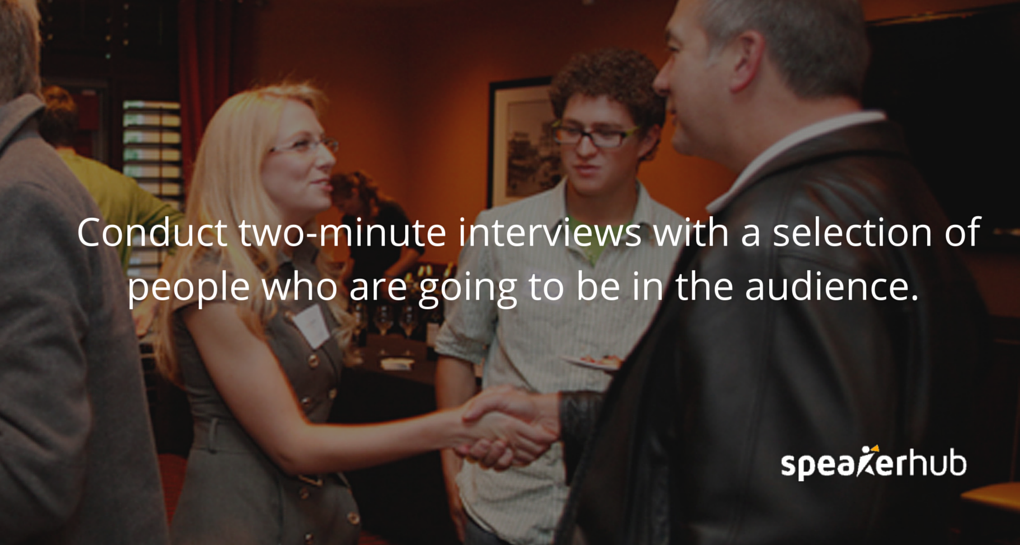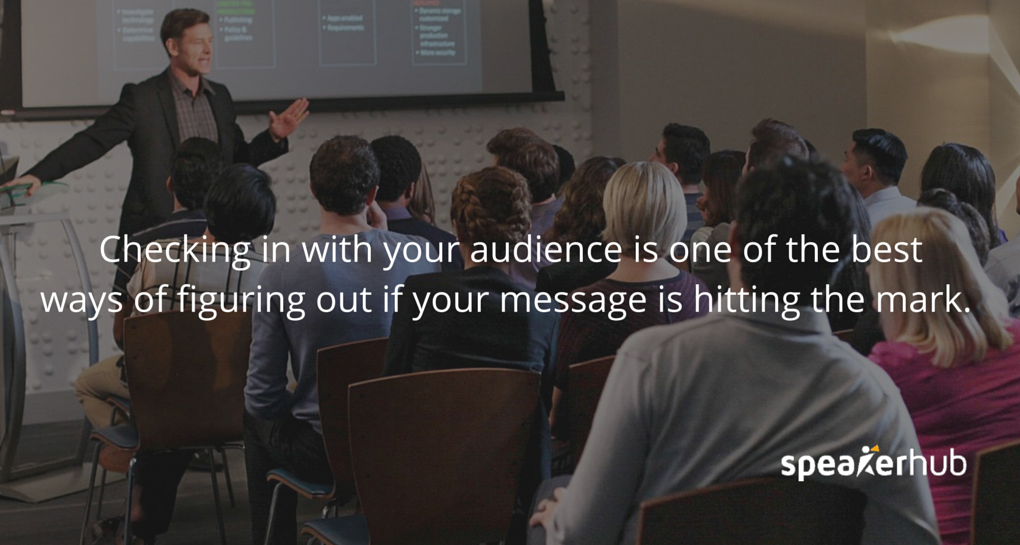Knowing your audience: the key to adapting your presentation

We all know the adage: good communication starts with listening.
As a speaker, however, this might seem counterintuitive. After all, you have been brought in to speak, not to listen.
But the difference between someone who can get up on stage and deliver a box-standard speech, versus someone who can get up on stage and inspire and engage an audience, can be vast.
If you’d like to give a talk that will move your audience, be memorable, and have an impact, you are going to need to adapt it specifically for the people who are going to be listening to you.

Here are the five things to find out about your audience to make sure your talk is on point.
Get to know your audience:
- Knowledge base. What do they already know about your topic?
This will frame your talk, and determine whether you are going to need to spend the majority of your time giving them a broad overview, or whether you can get into the specifics.
If, for instance, you speak to a group of engineers about self-driving cars, you will most likely not need to start with the basics of how it works. On the other hand, if you explain micro-loans in Asia, they may know as little about it as any other non-expert.
Trying to get into the specifics when they don’t understand where you are coming from will have a negative impact and leave everyone frustrated – yourself included.
- Content expectations. Make sure you know what the audience thinks they are going to get out of the talk.
Are they expecting to walk away feeling inspired, or to have a new understanding of your topic?
Do they expect a motivational after-dinner speech, a political insight, or practical advice where to invest their savings?
Finding out why they are there to see you will help you meet their needs.
- Challenges and issues. Understanding the problems and setbacks your audience is facing is vital to creating a talk that will engage them.
Are they struggling with a management issue about workplace productivity? Have they just had a corporate scandal and you were brought in to provide a novel crisis management approach?
If you can directly address and offer them solutions, you will hook them and keep them interested.
- General attitude. How receptive your audience will be to your message can be a major factor in what you choose to focus on.
Are you talking about the reliability of clinical trials to pharma executives? Challenging conventional wisdom about the safety of a food additives?
If they are excited to learn more, you can jump right in. If your topic is controversial or a large portion of the audience already disagrees with you, you are going to need to spend more time persuading them to get get on board.
- Tone. Few things are worse than a presenter who has completely missed the tone of the event.
Cracking an inappropriate joke at a gala event? Using heavy statistics and corporate jargon at a fun retreat?
If things are light and humorous, coming in with a heavy and sombre talk will not match your audience, and vice-versa.
The timing and setting of your talk will also have a major effect on the tone you should adopt.
There are ways you can clarify this right after you’ve been contacted by the organizer, when you get to the event and ‘feel the room’, or even while you are on stage.
Before the Event

“By failing to prepare, you are preparing to fail. “
-Benjamin Franklin
There is a lot you can learn about your audience before you even step in the door, doing your research beforehand can help you to better organize your ideas, and angle your talk to suit your listeners.
Key questions to ask the organizer

Your research starts the moment you agree to give a talk: one of your best resources for finding out about your audience is going to be the person who asked you to give the talk.
-
Who is the target audience, and what are their expectations? Find out from the organizer who they ideally want you to address.
Is the audience high school students who are enrolled in advanced science class? Under privileged youth you’re expected to show a positive lifestyle?
This will give you a good idea as to whether your talk needs to be persuasive, informative, inspirational, or entertaining, and how to cater your message to suite the audience’s needs.
-
What are the demographics? Finding out about the general demographic of the audience, like age, sex, and occupational industry, will give you a leg up in customizing your talk, as the categories can help you understand the individual’s identities and experiences.
This being said, be wary of stereotyping your audience. Just because audiences above 60 tend to be less social-media savvy doesn’t mean that those in the room will not be SnapChat mavericks.
-
What is the room like, and what time are you presenting? The setting can be a major factor in how you set your tone and content.
Presenting right after lunch? You are going to need to be high energy. Will you be presenting outside? There maybe no tech for your PowerPoint. How are the tables arranged? If you cannot move around the room, you may need to adapt your style accordingly.
Finding out these details will help you adapt your talk.
Do your research
If you are presenting to an organization, learn about it as much as you can.
You can visit one of their locations, or their website, social media sites, and reading their blog. Notice the language style, the values, and the tone they use, and see if and where you can match it in your talk.
If you are presenting in a foreign country, make sure you’ve got a handle on the cultural differences of the audience. A joke that may work perfectly well in Germany may be culturally offensive in Japan.

What tone should you be using?
While in America, encouraging your audience to stand up and cheer, being flashy and exciting might work really well. In England this might turn the audience off.
Will religion be a factor? While kissing the event organizer on the cheek after they introduce you might be perfectly acceptable in North-Western Europe, in the Middle East it could cause an uproar.
Find out about their sense of humour, their communication style, and what gestures or language are inappropriate before you get there – whether through Wikipedia, or by watching Youtube videos, there are many sources to get the basics.
At the Event
You can easily get creative with your customization. Comedians and politicians use this tactic all the time to connect with their audience: find out something special or well known about the city or conference (e.g., when presenting in Amsterdam, a fun reference to bicycling etiquette would get you kudos if done well,) and mention it in your introduction.
Many speakers insist it is essential to attend the event before your talk.
Survey the space
Make sure you visit and survey the area where you are going to be presenting well before your presentation slot.
Use this time to make sure all of your equipment is working, but more importantly, how you can use the space to make the biggest impact.
Conduct a few short interviews
“If you just show up for your talk and then leave immediately, you do not have the time to really gauge the mood and the audience. When I'm invited, I always try to be there from the very beginning, even in the coffee break, and just ask people questions like “Why did you come to this conference? What brings you here? What are you expecting to gain?”
-Agnes Uhereczky, Policy Advisor (See more of her advice on SpeakerHub)
Conduct two-minute interviews with a selection of people who are going to be in the audience.
Remember to keep these conversational and short, with a wide selection of people; don’t just talk to one type of person (ie. just women, or only young people.)

Use these conversations to determine what their expectations, or challenges might be.
Greet the audience at the door
Toastmasters International, an organization that teaches public speaking, has a great tip: they recommend that the speaker greets people at the door, and uses these short interactions to ask questions about the audience's’ level of knowledge and expectations.
On stage
By this point, you should have a fairly good idea of who your audience is, and how you can meet their needs with your presentation.
Never be overconfident: what you expect, and what the reality will be, do not always line up.
When you get on stage, and throughout your presentation, continue to analyze the audience.
Watch them carefully for key signs in their body language that you are hitting the mark. If they are eagerly leaning forward, with smiles and lit up eyes, they are probably engaged.

However, if they are not making eye contact, they have folded arms and legs, or they look like they are about to fall asleep, you might have a problem.
Here are some things to be on the lookout for:
- Confusion. If the audience is looking at you with genuine confusion, or looking at you like you have just grown a third arm, chances are they do not have as much knowledge about the subject as you thought they did.
Backtrack a bit and take the time to clarify terms, or give a bit of background information. You can say: “I am just going to quickly go over some of the important important terms and concepts, to get everyone on the same page.”
It is much better to take a few moments to do this than to lose the majority of your audience.
- Boredom. Are they fidgeting, talking to their neighbor, or maybe they’ve even closed their eyes for a few seconds? You are going to need to spice things up.
Do something unpredictable, or add an element of audience involvement. Go off-script, or add a dash of humour.
- Unhappiness or anger. Take a scan of the room: are there frowns all around? You could have incorrectly assessed their attitude towards your topic, and you might need to switch tracks to be more persuasive, or offer more clarification on your perspective.
Do not wall yourself off from what the audience is feeling or conveying by spitting out the the rest of your talk and getting off stage. See if you can turn it around and get them on board with you instead.
Don’t forget that you can always ask your audience: there is no screen between you and them.
Get them involved. If they look confused, ask them if they understand what you are saying. If they look irritated, instead of second-guessing what the problem is, address it head-on.
Checking in with your audience is one of the best ways of figuring out if your message is hitting the mark.

Taking an audience-centered approach will make you a more effective speaker, and being able to adapt your presentation is key.
Often, there is a very fine line between over-adapting and under-adapting, but the more you practice it, the easier and more straightforward it will become.
Was this information helpful? What are some of the ways you adapt your presentation to your audience? We would love to hear from you, write to us to share your thoughts.






